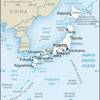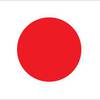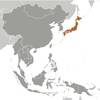Japan [+]Compare [E]dit [H]istory
Aliases: Nihon-koku/Nippon-koku, Nihon/NipponObject «Japan» was created due to
Add new object to «Japan» or move existing objects here.
Object «Japan» has attributes [Show empty attributes][Hide empty attributes]
| Attribute | Value |
|---|---|
| Geography | |
| Area | 377,915 km² |
| Continent | Asia |
| Land area | 364,485 km² |
| Water area | 13,430 km² |
| Land boundaries | 0 km |
| Border countries | Add |
| Coastline | 29,751 km |
| Mean elevation | 438 m |
| Lowest point | -4 m |
| Highest point | 3,776 m |
| People | |
| Population | 125,507,472 |
| Official languages | Add |
| Religion | Shintoism |
| Government | |
| Long country name | Add |
| Short country name | Japan |
| Long local name | Nihon-koku/Nippon-koku |
| Short local name | Nihon/Nippon |
| Former name | Add |
| Government type | Parliamentary constitutional monarchy |
| Capital | Tokyo |
| Economy | |
| GDP (PPP) | 5,443,000,000,000 USD |
| GDP (OER) | 4,873,000,000,000 USD |
| GDP (real growth rate) | 1.7 % |
| GDP - per capita (PPP) | 42,900 USD |
| Gross national saving | 28 % of GDP |
| Labor force | 65,010,000 |
| Unemployment rate | 2.9 % |
| Population below poverty line | 16.1 % |
| Budget revenues | 1,714,000,000,000 USD |
| Budget expenditures | 1,885,000,000,000 USD |
| Military expenditures | 0.92 % of GDP |
| Taxes and other revenues | 35.2 % of GDP |
| Budget surplus or deficit | -3.5 % of GDP |
| Public debt | 237.6 % of GDP |
| Inflation rate | 0.5 % |
| Central bank discount rate | 0.3 % |
| Commercial bank prime lending rate | 1.48 % |
| Stock of narrow money | 6,317,000,000,000 USD |
| Stock of broad money | 6,317,000,000,000 USD |
| Stock of domestic credit | 13,070,000,000,000 USD |
| Market value of publicly traded shares | 4,895,000,000,000 USD |
| Current account balance | 196,100,000,000 USD |
| Exports | 688,900,000,000 USD |
| Imports | 644,700,000,000 USD |
| Reserves of foreign exchange and gold | 1,264,000,000,000 USD |
| External debt | 3,240,000,000,000 USD |
| National currency | yen |
| National currency (code) | JPY |
| National currency (symbol) | ¥ |
| National currency rate to USD | 111.1 |
In 1603, after decades of civil warfare, the Tokugawa shogunate (a military-led, dynastic government) ushered in a long period of relative political stability and isolation from foreign influence. For more than two centuries this policy enabled Japan to enjoy a flowering of its indigenous culture. Japan opened its ports after signing the Treaty of Kanagawa with the US in 1854 and began to intensively modernize and industrialize. During the late 19th and early 20th centuries, Japan became a regional power that was able to defeat the forces of both China and Russia. It occupied Korea, Formosa (Taiwan), and southern Sakhalin Island. In 1931-32 Japan occupied Manchuria, and in 1937 it launched a full-scale invasion of China. Japan attacked US forces in 1941 - triggering America's entry into World War II - and soon occupied much of East and Southeast Asia. After its defeat in World War II, Japan recovered to become an economic power and an ally of the US. While the emperor retains his throne as a symbol of national unity, elected politicians hold actual decision-making power. Following three decades of unprecedented growth, Japan's economy experienced a major slowdown starting in the 1990s, but the country remains an economic power. In March 2011, Japan's strongest-ever earthquake, and an accompanying tsunami, devastated the northeast part of Honshu island, killed thousands, and damaged several nuclear power plants. The catastrophe hobbled the country's economy and its energy infrastructure, and tested its ability to deal with humanitarian disasters. Prime Minister Shinzo ABE was reelected to office in December 2012, and has since embarked on ambitious economic and security reforms to improve Japan's economy and bolster the country's international standing.
Similar objects
Most often compared with
Everyone can something to edit or add.
There was one edit, no edits waiting approval. Last edited by avery54(9375), Sep 16, 2019 (60 fields were changed)
Help · Contact us · Disclaimer · Contributors · Developers · Donate


